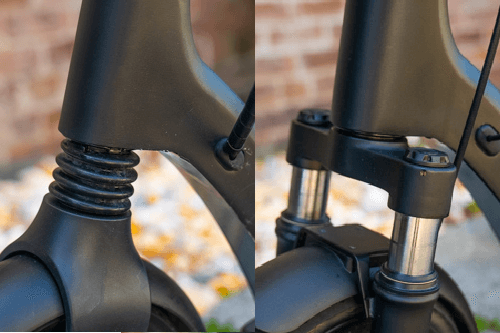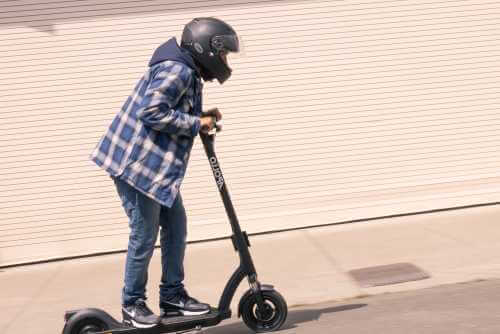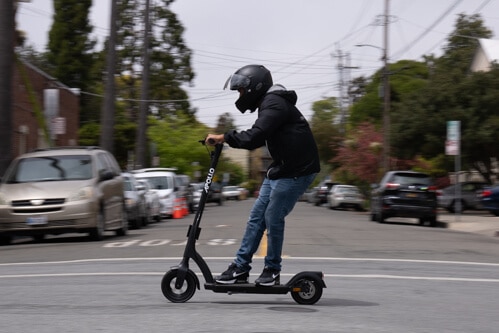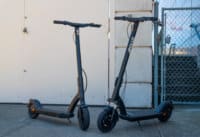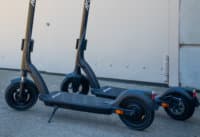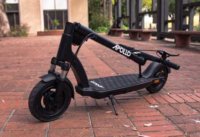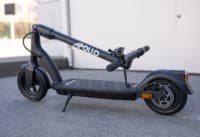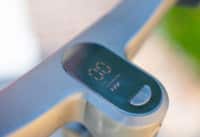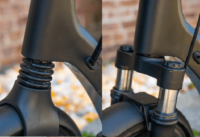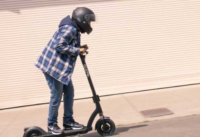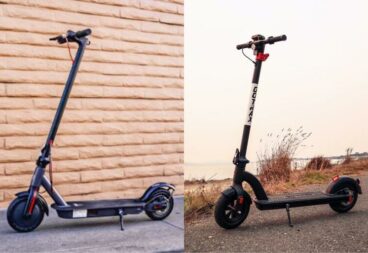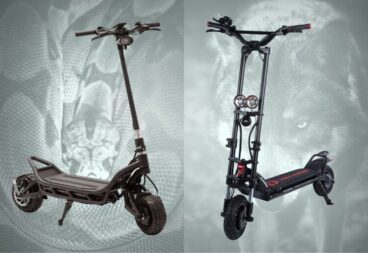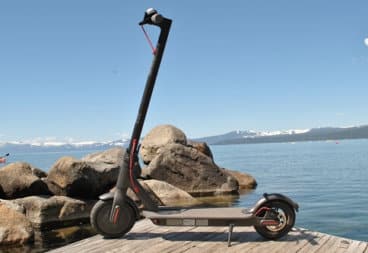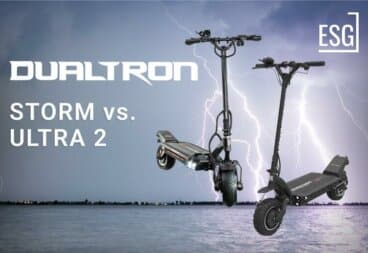As all-new models available from Apollo, the Air and Air Pro make beginner friendly anything but boring. With an attractive, striking design and exceptional stability, the Air and Air Pro offer first-time riders a safe but sporty, fun ride in slightly different packages.
Apollo Air vs. Apollo Air Pro Comparison
| Apollo Air | Apollo Air Pro | |
|---|---|---|
| | Apollo Air | Apollo Air Pro |
| MSRP (USD) | $699 | $799 |
| Top Speed | 15.6 mph | 18.8 mph |
| Range | 13.9 mi | 17.7 mi |
| Weight | 35 lb | 35 lb |
| Rider Weight | 220 lb | 220 lb |
| Accel: 0 to 15 mph | 7.1 s | 6.0 s |
| Braking Distance | 17.5 ft | 11.4 ft |
| Hill Climb Time | 32.2 s | 21.8 s |
| Battery Capacity | 281 wh | 374 wh |
| Motor | 250 w | 350 w |
| Tires | Front: 10.0 in Rear: 9 in | Front: 10.0 in Rear: 10.0 in |
| Rims | Front: Solid Rear: Split | Front: Solid Rear: Solid |
| Suspension | Front: Single spring Rear: None | Front: Dual spring Rear: None |
| Brakes | Front: None Rear: Disc + Regen | Front: Drum Rear: Regen |
| IP Rating | IPX4 | IPX4 |
Our content is independent, but buying through our links may earn us a commission.
Our content is independent, but buying through our links may earn us a commission.
Apollo Air vs. Apollo Air Pro Performance
The Air and Air Pro have very similar performance and limited top speed (both under 20 mph). Comparing their acceleration patterns, the Pro gets off the start line a bit faster hitting 15 mph in 6.0 s, about 1 s faster than the base Air.
One area where the performance is strikingly different is braking. With a more effective dual braking configuration, featuring a front drum brake and rear regen, the Air Pro has a 35% shorter braking distance than the base Air, which is a significant difference in an emergency.
For context, if there were an average car’s length between you and a wall, you’d stop before hitting the wall on the Pro but wouldn’t be able to stop in time on the base Air.
Apollo Air: Pros + Cons
Lower cost packing many of the same features as the Pro. The base Air is around $200 less than the Air Pro, which is a significant difference and a cost savings that you could apply towards safety accessories (like a helmet or riding gloves). The Air has front spring suspension and high quality features that you wouldn’t expect in an entry-level scooter, with a slightly smaller rear wheel and different braking configuration than the Pro.
Great for smaller riders with lighter weight and slightly smaller footprint. At 35 lb, the Air is 3 lb lighter than its Pro counterpart. It’s also 0.5 in shorter in height, length, and deck clearance. The slightly smaller rear tire and smaller motor contribute to the size difference, which is probably noticed most by petite riders. This smaller footprint makes it easier for riders with shorter, small frames to hoist the scooter into trunks. Also, the lower deck clearance means you’re closer to the ground during takeoff, landing and in case you need to bail.
Split-rim rear tire makes maintenance easier. Out of the four tires between the two models, only the rear 8.5 in tire on the Air is on a split rim. Split rims make it easier for riders to open the wheel and replace the inner tube should you get a flat. Solid rims have to be removed from the scooter before you can get to the inner tube, so they’re a bit more difficult to maintain. Since flats happen most frequently on the rear tire, it’s a nice feature to make the Air a little more beginner friendly.
Apollo Air Pro: Pros + Cons
With the Pro, you can go 4 mi further per charge. Getting a little more range, the Air Pro extends the length you can make your commute. Keep in mind that the average commute in the U.S. is around 7 mi, so the Pro could get you to and from your destination without inducing range anxiety.
Quicker acceleration allows you to more easily avoid accidents in traffic. When it comes to acceleration, a full 1 s is a huge divide, and the Pro beats the base Air from 0 to 15 mph by 1.1 s. Although neither Air is super quick, that slight advantage could allow you to ride more comfortably with traffic, as you often need to make quick, slight movements to avoid incidents with other drivers and obstacles.
Faster overall top speed means you can more easily pass others in the bike lane. If you hate being stuck behind bicyclists and others on the road, the Air Pro will get you ahead of the pack. The Pro has a 3 mph faster tested top speed than the base Air. As most bicyclists’ and shared scooters’ speed tops out at around 15 mph, going 18.8 mph allows you to pass and take the lead when contending with most riders traveling in the bike lane.
Verdict: Depends
Both the Apollo Air and Apollo Air Pro have exceptional stability and front suspension, which are not common features on entry-level scooters. They’re both fairly portable and geared towards beginner riders up to 220 lb, with the Pro great for most riders and the base Air slightly better suited to lighter, shorter riders.
Base Is Better for Smaller Riders
With a slightly lighter and smaller build for a little less money, the base Air is slightly easier to handle for smaller riders, while offering much of the strong feature set of the Pro. The deck-to-handlebar height remains the same between models, but the overall scooter’s length and height as well as the deck clearance off the ground decreases by 0.5 in. Although it sounds small, a 3 lb lighter build makes a big difference when you’ve got other things that you’re wearing and carrying.
More Money = More Performance
For more weight and money, the Air Pro steps up the performance slightly, with more power resulting in better range, top speed, hill climbing ability and acceleration. It also has far better braking with a front and rear braking configuration. Other than stopping and hill climbing power, the base Air doesn’t trail far behind the Pro in performance, but the ride quality is far more extraordinary than any of its specs.
